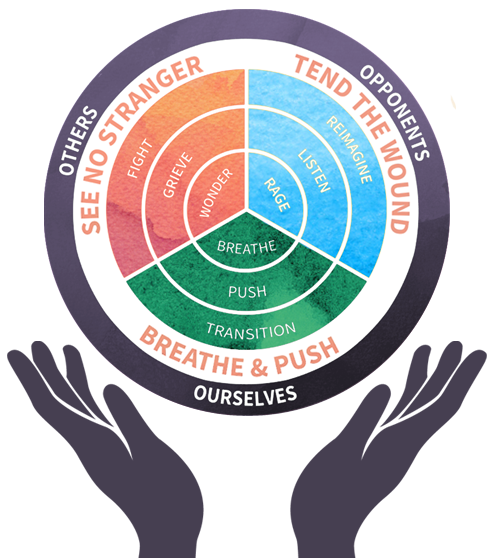2: Grieve

“Grief is the price of love. Loving someone means that one day, there will be grieving. They will leave you, or you will leave them. The more you love, the more you grieve. Loving someone also means grieving with them. It means letting their pain and loss bleed into your own heart. When you see that pain coming, you may want to throw up the guard rails, sound the alarm, raise the flag, but you must keep the borders of your heart porous in order to love well. It is an act of surrender. . . . When we are brave enough to sit with our pain, it deepens our ability to sit with the pain of others. It shows us how to love them.”
“We come to know people when we grieve with them through stories and rituals. It is how we can build real solidarity, the kind that points us to the world we want to live in—and our role in fighting for it….America’s greatest social movements—for civil rights, immigrants’ rights, women’s rights, union organizing, queer and trans rights, farmworkers’ rights, indigenous sovereignty, and black lives—were rooted in the solidarity that came from shared grieving. First people grieved together. Then they organized together….When people who have no obvious reason to love each other come together to grieve, they can give birth to new relationships, even revolutions.”
—Valarie Kaur, See No Stranger, Chapter 2
Understanding Grieve
A Practice of Love for Others
To grieve with others is to share their pain, without trying to minimize or erase it. Grieving with others requires a willingness to be transformed by their experiences, especially those who have suffered trauma and violence. Grieving collectively and in community gives us the information to build solidarity, to fight for justice, and even to share in one another’s joy.
- Where do you notice feeling grief in your body? What is the quality of that grief? What is the shape of grief inside of you? If it feels uncomfortable, take another deep breath and stay with it. Breathe through it.
- What does your body need to be brave with this grief? What do you need to feel it and to move through this energy? What rituals are you called to? Who do you need by your side.
- Who have you not yet grieved with? Whose story have you not fully let into your heart? What community’s struggle have you not fully taken in? Notice what is happening in your body. If your fists tighten, or your heart beats fast, or if shame rises to your face, it’s okay. Breathe through it. Trust that you can. The heart is a muscle: The more you use it, the stronger it becomes. You don’t need to know people in order to grieve with them. You grieve with them in order to know them.
- What do you need to do to be able to grieve with them? What vigils or marches need you? What houses of worship are you ready to visit? What phone call are you ready to make? You can begin where you are, with a simple text or email, saying to someone “I’m here for you.”
- How is grieving an act of love? How can collective grieving with others be a practice of solidarity and a revolutionary act?
- How can the practice of wonder help us to love and grieve with others, even those we do not know?
- What is at stake for us when we grieve together? What is to be gained? What is lost when we have failed to grieve as a nation?
- Grieve in community. Grieve with the living.
- Reach out to someone who you know who is grieving. Listen to them. It is okay if you don’t know what to say; your presence is medicine. If you need words, you can say: You are grieving but you are not grieving alone. Notice what it feels like in your body as you do this.
- If you are grieving a loved one, create a container for your grief. You can create a grief altar with objects and photos and lit candles. You can plant flowers or seeds in their memory. Create art or scrapbooks with photographs. Write letters to your loved one and go to the sea or forest to read out loud the words that were unsaid. Choose a sacred prayer or song or mantra to recite. Carry an object that reminds you of who you are grieving. Love outlasts life. They are still part of you.
- If you are grieving with communities harmed in violence, send messages of love to those harmed. Show up in person or online to public memorials or vigils to grieve with the living. Donate to funds to support these families and communities if you are able. Explore these communities’ histories to learn more about intergenerational trauma and resilience.
- Be present with the pain of others and let their pain inform what you fight for.
- Write in your wisdom journal: What are you learning from grieving with others? What information have you gained about those you are grieving with? What are you learning about yourself?
- Go gently. If you find a moment when you say: It’s too much—all this grief, all this violence and injustice, it’s too hard — do not to judge the emotions in your body. Let them come and go. There is something called “empathy fatigue” that happens when we get overloaded by other people’s pain. The good news is that you don’t need to feel empathy all the time. Remember our definition of love: Love is not a rush of feeling: Love is sweet labor. It begins with wonder. Let the feelings come and go. What matters is the work your hands do. Rest, then return with wonder.

